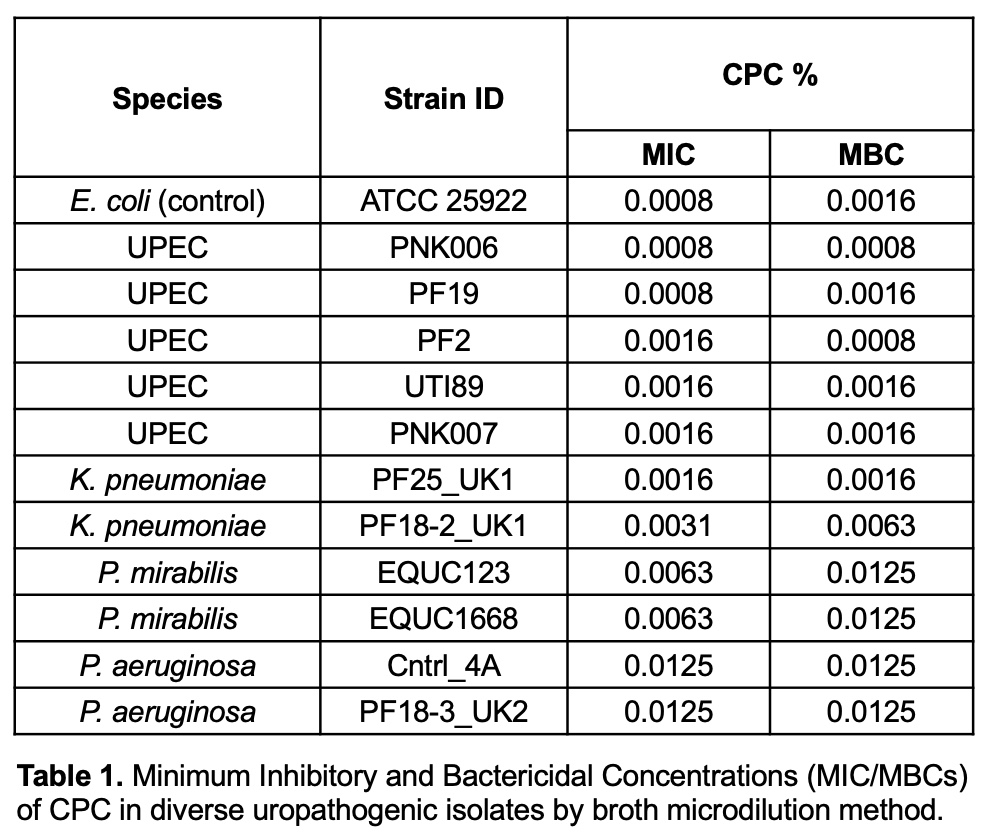Back
Poster, Podium & Video Sessions
MP02: Infections/Inflammation/Cystic Disease of the Genitourinary Tract: Kidney & Bladder I
MP02-17: Molecular Analysis of Cetylpyridinium Chloride for Use in Bladder Instillation Therapy in the Advanced Management of Recurrent Urinary Tract Infections
Friday, May 13, 2022
7:00 AM – 8:15 AM
Location: Room 225
Samuel Chang, Namrata Sawant, Richardson, TX, William Warner, Punta Gorda, FL, Philippe Zimmern, Dallas, TX, Nicole De Nisco*, Richardson, TX

Nicole De Nisco, PhD
Assistant Professor
University of Texas at Dallas
Poster Presenter(s)
Introduction: Treatment of recurrent urinary tract infections (rUTI) has become increasingly difficult due to the rise of antibiotic resistance among uropathogens. Alternative uses of existing antimicrobials, such as antimicrobial bladder instillations, have become the subject of increased attention. Cetylpyridinium chloride (CPC), a cationic detergent, may be a promising candidate for use in bladder instillations. A preliminary trial reported mild symptoms of bladder irritation in women with antibiotic refractory rUTI, who underwent bladder instillation using 0.05% CPC. The aim of this study was to identify the minimum inhibitory and bactericidal concentrations (MIC/MBCs) of CPC against diverse uropathogenic bacteria to design an optimal CPC instillation strategy for women with rUTI.
Methods: Following IRB approval, uropathogenic Escherichia coli (UPEC), Klebsiella pneumoniae, Proteus mirabilis, and Pseudomonas aeruginosa were isolated from urine collected from postmenopausal women with active rUTI. Serial two-fold dilutions of CPC were placed into a microtiter plate. Overnight cultures grown in Mueller Hinton (MH) broth were normalized to an OD600 of 0.05 and were inoculated into each well. Following overnight static incubation at 37°C, growth was measured. The MIC was recorded as the lowest concentration of CPC for which no growth was visible. 10 µL from wells with no growth was spotted onto MH Agar (MHA). The concentration for which no growth occurred on MHA was recorded as the MBC.
Results: The MIC and MBC of CPC ranged from 0.0008% to 0.0016% for UPEC and from 0.0016% to 0.0063% for K. pneumoniae. P. mirabilis had an MIC of 0.0063% and MBC of 0.0125%. The MIC and MBC of CPC for P. aeruginosa were both 0.0125%. A CPC concentration as low as 0.0125% exhibited bactericidal activity against all tested uropathogens.
Conclusions: This study determined that 0.0125% CPC shows bactericidal activity against diverse uropathogens. Future bladder instillation trials using 0.0125% CPC could potentially alleviate reported symptoms of bladder irritation. Continued work will focus on studying the cytotoxic effects of CPC against bladder epithelial cells and the pharmacodynamics of CPC through a time-kill kinetic assay.
Source of Funding: The Felecia and John Cain Distinguished Chair in Women’s Health, in Honor of Philippe Zimmern, M.D.

Methods: Following IRB approval, uropathogenic Escherichia coli (UPEC), Klebsiella pneumoniae, Proteus mirabilis, and Pseudomonas aeruginosa were isolated from urine collected from postmenopausal women with active rUTI. Serial two-fold dilutions of CPC were placed into a microtiter plate. Overnight cultures grown in Mueller Hinton (MH) broth were normalized to an OD600 of 0.05 and were inoculated into each well. Following overnight static incubation at 37°C, growth was measured. The MIC was recorded as the lowest concentration of CPC for which no growth was visible. 10 µL from wells with no growth was spotted onto MH Agar (MHA). The concentration for which no growth occurred on MHA was recorded as the MBC.
Results: The MIC and MBC of CPC ranged from 0.0008% to 0.0016% for UPEC and from 0.0016% to 0.0063% for K. pneumoniae. P. mirabilis had an MIC of 0.0063% and MBC of 0.0125%. The MIC and MBC of CPC for P. aeruginosa were both 0.0125%. A CPC concentration as low as 0.0125% exhibited bactericidal activity against all tested uropathogens.
Conclusions: This study determined that 0.0125% CPC shows bactericidal activity against diverse uropathogens. Future bladder instillation trials using 0.0125% CPC could potentially alleviate reported symptoms of bladder irritation. Continued work will focus on studying the cytotoxic effects of CPC against bladder epithelial cells and the pharmacodynamics of CPC through a time-kill kinetic assay.
Source of Funding: The Felecia and John Cain Distinguished Chair in Women’s Health, in Honor of Philippe Zimmern, M.D.


.jpg)
.jpg)